

| Home | Log In | Register | Our Services | My Account | Contact | Help |
You are NOT currently logged in
dai oldenrich - 01 Sep 2006 13:32
click your browser refresh button to update charts
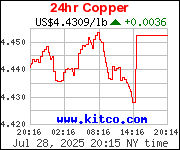
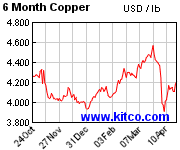
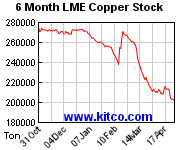
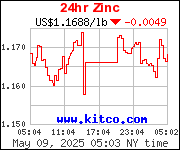
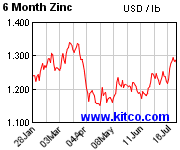
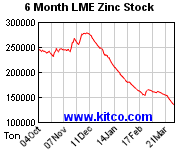
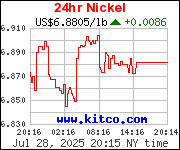
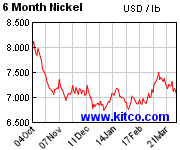
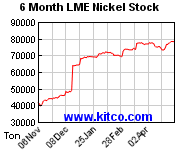
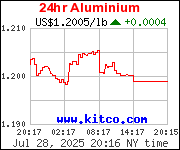
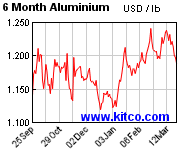
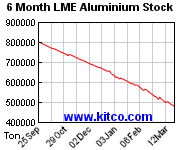
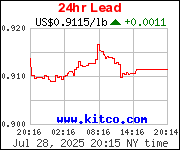
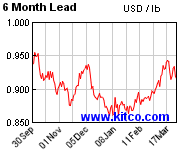
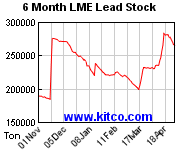
Also see: gold charts here silver charts here platinum charts here
dai oldenrich - 04 Sep 2006 22:19 - 12 of 181
Mon Sep 4, 2006
4-Nickel tumbles 4 percent by end of LME trading
By Anna Stablum
LONDON, Sept 4 (Reuters) - Nickel prices took a severe beating in late trade at the London Metal Exchange on Monday, falling over $1,000 from Friday's kerb close.
Three-months futures ended Monday's kerb at $27,600 per tonne, down $1,100, or 3.8 percent. Once selling began, the metal slipped into free-fall, traders said.
"It was around $28,500, then on the next trade -- which was half an hour later -- it had gone down $300, then another $300." Volumes were tiny and support practically non-existent.
"It was trading one lot, then two lots, then one. There was a void underneath it," the trader said.
Sellers may have been anticipating a large rise in stocks when figures are released at 0800 GMT on Tuesday, he said.
Earlier, traders had said that the longer nickel failed to break resistance at $30,000, the likelier it was to fall.
Nickel hit a record high of $29,250 on August 22, supported by low visible stock levels, and strong demand from stainless steelmakers.
Nickel's backwardation, the premium for cash settlement over three-month delivery, eased to around $2,200 per tonne from $3,400 on Friday.
None of the other LME metals were as active.
Copper prices rebounded slightly as demand was expected to pick up after the European summer holidays, but trading was light on Monday with U.S. markets closed for Labor Day, dealers said.
Copper for delivery in three months ended the kerb at $7,650 versus $7,590 on Friday.
The market had been buoyed by the apparent return of Chinese buyers to the physical market, a Macquarie report said.
"The market mood feels more and more bullish as the seasonally-stronger demand period approaches," it said.
Also, funds tended to allocate fresh money at the start of each month and looming supply disruptions supported sentiment.
"These factors will continue to underpin copper prices for the remainder of the year and, as such, we expect a strong fourth quarter for the red metal," a Standard Bank report said.
As a result, it raised its 2006 cash price forecast to $6,725 from an earlier forecast of $6,600.
MINING STOCKS
Director John Meyer at Numis Securities said the mining sector looked set for further gains after the sell-off in May that took at least 15 to 20 percent off values.
"A generally more positive outlook for equity markets, combined with increasing earnings potential across the mining sector should continue to attract interest," he said in a note.
Three months aluminium ended the day at $2,489, down $1. Zinc was at $3,470, up $30.
Tin was at $9,050, up $150 from its close on August 31, while lead ended the kerb at $1,257, up from $1,225 on Friday.
dai oldenrich - 05 Sep 2006 07:27 - 13 of 181
Copper in Shanghai Rises to Seven-Week High Amid Supply Concern
By Chia-Peck Wong
Sept. 5 (Bloomberg) -- Copper futures in Shanghai rose to their highest in seven weeks amid concerns that stockpiles held in Chinese warehouses may not be able to meet demand.
Copper in London, the world's biggest metals market, soared to a record in May, leading Chinese users to cut imports and rely on domestic stockpiles. Inventories monitored by the Shanghai Futures Exchange fell 17 percent this year to 48,193 metric tons on Aug. 31. That also marks a 40 percent decline from a 19-month high of 75,264 tons reached on Dec. 1.
``Stockpiles are still contracting, leading to rising prices for cash and front-month deliveries, which is lifting prices for all contracts,'' Cai Luoyi, a metal analyst at China International Futures (Shanghai) Co., said by phone today.
Metal for delivery in November rose by as much as 1,340 yuan, or 1.9 percent, to 71,660 yuan ($9,026) a ton on the Shanghai Futures Exchange, the highest since July 17. It traded at 71,210 yuan at 10:44 a.m. local time.
Copper for three-month delivery rose $40, or 0.5 percent, to $7,690 a ton on the London Metal Exchange at 10:42 a.m. Shanghai time.
China, the world's biggest copper user, reduced imports of the metal this year after the price soared to a record $8,800 a ton on May 11. The nation imported 477,220 tons of copper from January through July, 42 percent less than a year earlier, according to data released by the China Customs General Administration on Aug. 25.
Copper for delivery in December rose 2.9 cents to $3.49 a pound in after-hours trade on the Comex division of the New York Mercantile Exchange at 10:41 a.m. Shanghai time.
dai oldenrich - 05 Sep 2006 19:49 - 14 of 181
Tuesday, September 05, 2006 - Dow Jones Newswires
Gold Eyes $645 On Strong Physical Buying
0656 GMT [Dow Jones] Physical buying interest in gold in Asia likely to remain feature over next couple of months as market enters period of traditionally strong physical interest, says James Moore at TheBullionDesk.com; "While softer energy prices are curbing some of gold's price potential, the recent rallies in platinum and silver suggest sentiment is gradually turning more bullish." Gold could potentially move towards $645 once resistance around 100-day moving average of $633.60 is cleared; spot gold last up $2.75 at $629.25/oz. (GLS)
HARRYCAT
 - 05 Sep 2006 21:30
- 15 of 181
- 05 Sep 2006 21:30
- 15 of 181
Doing a good job daiO.
Keep 'em coming.
Keep 'em coming.
dai oldenrich - 06 Sep 2006 07:14 - 16 of 181
Copper in Shanghai Soars to 3-Month High as Stockpiles Rebuilt
By Chia-Peck Wong
Sept. 6 (Bloomberg) -- Copper futures in Shanghai rose to their highest in more than three months on speculation cable and wire makers in China may continue buying to replenish stockpiles.
These buyers cut their purchases when copper prices soared to record levels in May, preferring to rely on inventories, traders such as Wang Zheng said. They have stepped up buying recently, as seen in the widening premium commanded by the nearest futures contract over more distant ones, he said.
``They can't keep relying on stockpiles, they had to start buying,'' Wang, a metal trader at Shanghai Dalu Futures Co., said by phone today.
Copper for delivery in November, the most actively traded contract, rose as much as 2,850 yuan, or the maximum allowable daily limit of 4 percent, to 74,120 yuan ($9,323) a metric ton on the Shanghai Futures Exchange. That's the highest since May 30. It traded at 73,960 yuan by the market's midday break.
The November contract is cheaper than the so-called front- month contract, for September delivery, a condition known as backwardation in commodity markets that signals that current supply may not be enough to meet demand. The September contract traded at 74,100 yuan by the midday break.
The front-month contract has commanded a premium over the most actively traded contract since Aug. 18, coinciding with a 12 percent drop in copper stockpiles monitored by the exchange since Aug. 17.
Metal for immediate delivery in Changjiang, Shanghai's biggest spot market, rose as much as 3.4 percent today to 74,300 yuan a ton. Chinese users have to pay 17 percent value-added tax, 2 percent import tax, premiums and freight charges for imported copper.
Copper for three-month delivery on the London Metal Exchange rose $90, or 1.1 percent, to $8,010 a ton at 12:35 p.m. Shanghai time.
Metal for delivery in December rose 1.35 cents, or 0.4 percent, to $3.638 a pound in after-hours trade on the Comex division of the New York Mercantile Exchange at 12:25 p.m. Shanghai time.
dai oldenrich - 06 Sep 2006 07:19 - 17 of 181
Business (smh.com.au) - September 6, 2006
BHP and Rio Tinto hot to trot with India - The big two have noted how fast this economy is growing - and acted, Jamie Freed reports.
IF INVESTORS were to place bets on the fastest-growing market for BHP Billiton's commodities, it seems likely that nearly all would place China at the top of the list.
After all, for the past few years Australians have heard endless stories about the China-led resources boom which has proven a huge boon to miners.
But as BHP chief executive Chip Goodyear noted after reporting a record-breaking $US10.5 billion profit last month, the Indian market is growing faster than that of China.
"We haven't talked about India in the past, but it is a growing percentage of our sales," he said. "It's growing faster than China, actually, but it's coming off a much lower base.
"Economic growth has been progressing solidly in India and it is continuing to outperform the expectations we see."
BHP sold $US1.24 billion of products into the Indian market last year - primarily coking coal and copper concentrate - which was nearly triple the $US425 million it sold the previous year. That's still only about one-sixth the amount it sells to China, but given that India's population is expected to be higher than China's by about 2030, the subcontinent is proving to be an increasingly important market for BHP.
And for BHP, India is more than just a destination for its products. The company has three offices in India and is exploring there for commodities including diamonds, bauxite and iron ore. There are also reports it might bid in India's latest petroleum block offering.
"We see India as a good opportunity for us," BHP spokeswoman Samantha Evans said.
Rio Tinto has taken a similar view. India has long been a huge market for rough diamonds from the company's Argyle mine in Western Australia. About 250,000 workers in the Mumbai and Gujarat areas are directly employed in cutting or polishing diamonds from Rio's mines.
But Rio isn't content to just ship diamonds to India anymore. Since 2001, the company has spent about $US21 million ($27 million) on diamond exploration in the country, and it is also looking for iron ore.
"We believe the Indian minerals sector has a bright future ahead of it," said Rio chief financial officer Guy Elliott in a speech to the UK-India Business Leaders' Forum in London in June. "With the right business environment and in partnership with experienced global mining companies, India can unlock its wealth and the country could be a major player in the world minerals markets.
"This sets it apart from China, whose intensity of minerals use is in any case very different and whose mineral resources are less abundant."
A PricewaterhouseCoopers report on the world mining industry this year said India had the potential to be an excellent investment destination.
"When compared to other competing emerging mining markets, the expenditure outlay in India seems low compared to its prospects," the report said. "This gap is likely to be met by the private sector, providing exceptional opportunities for those who are bold enough to invest."
But although India might be more prospective from an exploration point of view, there are some steep hurdles to overcome before a company can build a world-class mining operation.
Austrade's senior trade com-missioner for India, Mike Moignard, says it now takes a "long, long time" to receive government approvals and few mining leases had been granted in the last few years. For example, Rio has been working for about a year to gain a prospecting licence to accelerate its evaluation work in diamonds, so far without success.
Following a recent Indian Government review of the nation's mining policy, the timetables could be sped up.
"That review is with the prime minister and we are hopeful the Government will put forward some changes to make the going easier for foreign investment," Moignard says.
"I think that India is awake to the realisation they've got to expand their mining sector, which a few years ago they really weren't."
It's understood BHP and Rio both made submissions to the government committee reviewing the mining legislation, and that the Australian Government provided some informal advice.
But even if it becomes easier to gain exploration and mining licenses, challenges will persist.
Unlike China, India's recent economic boom has been based more on services and technology rather than manufacturing and infrastructure.
The New York Times last week noted that China invests $7 on roads, ports, electricity and other infrastructure for every $1 spent by India. So obtaining the power, water, and supplies needed to build a large-scale mining operation on the subcontinent could prove especially difficult.
"In short, investing in large resource projects in India is not for the faint-hearted," Rio's regional vice president of India, Nik Senapati, said earlier this year.
Austrade's hope is that Australian companies such as BHP and Rio - but also engineering, construction and contracting firms - can provide some of the expertise needed to improve India's infrastructure. The government agency is sponsoring the International Mining & Machinery Exhibition in Kolkata in November and has also arranged a tour of Indian iron ore and coal mining operations for interested Australian business leaders in tandem with the conference.
BHP is exploring the possibility of providing raw materials and infrastructure to a proposed steel plant which would be built by Korea's Posco.
As Moignard notes, India's gross domestic product is expected to grow by about 9 per cent a year for the next several years, and a lot of that will be dependent on steel production.
"The Government has to look very seriously at both its mining policy and infrastructure program to enable that growth do occur without bottlenecks," he says.
India has large reserves of iron ore - it even exports some to China on the spot market - but it lacks high-quality coking coal and is forced to import some of it from Australia.
Rio and BHP are both interested in helping out the burgeoning Indian steel industry, but they would prefer to remain upstream suppliers. Unfortunately, some states are trying to require miners to build downstream operations to provide additional jobs to aid economic growth.
BHP says it is willing to investigate downstream "value additions" where applicable, but Rio's Elliott thinks the requirement - along with a huge amount of bureaucratic red tape - has proven a disincentive for foreign mining investment.
"In my job, a great many investment proposals cross my desk," he said.
"Attracting mining investment is a competitive business. As a result its of administrative processes, India may be missing out on a potential boom.
"This is certainly the risk it runs in the minerals sector."
dai oldenrich - 06 Sep 2006 21:50 - 18 of 181
Aluminum Jumps to 7-Week High in London; Copper, Nickel Gain
By Chanyaporn Chanjaroen
Sept. 6 (Bloomberg) -- Aluminum jumped to a seven-week high in London, while nickel and copper gained as investors speculated that an expanding world economy will spur demand for the metals, creating a supply shortfall.
The global economy will grow in line with an April forecast of 4.9 percent, the International Monetary Fund's managing director Rodrigo de Rato said yesterday at a speech in Washington. Economic growth spurs demand for industrial metals including copper and aluminum.
``The underlying demand for all metals is very strong,'' Kona Hague, an analyst at London-based Economist Intelligence Unit, said today by phone. `` Aluminum, nickel stocks are falling and what you see now reflects the general bullishness in metals.''
Aluminum for delivery in three months rose $61, or 2.4 percent, to $2,634 a metric ton as of 7:06 p.m. on the London Metal Exchange, after earlier touching $2,640.25, the highest since July 14. The contract has gained 15 percent this year, trading at record $3,310 a ton May 11.
Nickel for delivery in three months gained $500, or 1.8 percent, to $28,400 a ton. The metal has more than doubled this year.
``We see prices of metals peaking in 2007 on delay of supply response'' to soaring metals prices, Haque said.
Inventory Increase
Nickel inventory tracked by the London Metal Exchange rose 474 tons, or 8.1 percent, to 6,360 metric tons today, the biggest increase in a month, according to daily report from the exchange today. The stockpiles have plunged 82 percent this year amid soaring demand from Chinese steelmakers and are sufficient for about two days of global usage.
``You wouldn't say we're out of the woods in terms of not running out of any stocks,'' said David Thurtell, a metals analyst at BNP Paribas in London. ``It's still critically tight.''
Stockpiles of aluminum dropped 1,600 tons, or 0.2 percent, to 713,200 tons, the exchange said today. That is adequate for less than eight days of global consumption.
Aluminum will be in a supply shortfall of 187,000 tons this year, according to a Citigroup report released yesterday. Analysts Alan Heap and Thomas Price revised down their aluminum- price forecasts 7.2 percent, estimating aluminum for immediate delivery to average $1.114 a pound ($2,455 a ton) in the second half of this year. Prices averaged $2,534 a ton in the first half of the year.
The global nickel market is likely to see a supply shortfall through next year as demand climbs about 10 percent this year, and 7 percent in 2007, the analysts said.
Copper Demand
Demand for copper will outpace supply by 101,000 tons this year due to mine disruptions, following a shortfall of 102,000 tons last year, the analysts said. The deficit will widen to 229,000 tons next year, a fifth straight year of shortfall. Prices of copper will average $3.247 a pound ($7,158 a ton) in the second half, they said.
``The copper market still is vulnerable to a lot of hot spots, strikes,'' said Edward Meir, an analyst at Man Financial Ltd. in Darien, Connecticut. ``Chinese demand seems to be picking up after a few months of a decline. The market still looks like it's going to be in a deficit next year.''
Copper for delivery in three months on the LME gained $120, or 1.5 percent, to $8,040 a ton, gaining for a third straight day. The contract has more than doubled in the past year, trading at a record $8,800 a ton May 11.
Copper for December delivery rose 3.5 cents, or 1.5 percent, to $3.6795 a pound at 1 p.m. on the Comex division of the New York Mercantile Exchange. A futures contract is an obligation to buy or sell a commodity at a fixed price for a specific delivery date.
Lead soared $62, or 4.8 percent, to $1,343 a ton, the highest since the close of Feb. 6.
dai oldenrich - 06 Sep 2006 21:51 - 19 of 181
Gold Falls in London, N.Y. as Gains May Have Been Exaggerated
By Pham-Duy Nguyen and Julie Tay
Sept. 6 (Bloomberg) -- Gold declined in London and New York as investors sold the precious metal on speculation gains in the past two weeks have been exaggerated.
The seven-day relative strength index of spot gold rose to 70 yesterday, a signal the metal may drop. Gold futures have had two straight weekly gains and yesterday rose the most in eight weeks in New York.
``With the market up $14 yesterday, there had to be a pullback today,'' said Mike Sander, a commodity broker at Altavest Worldwide Trading Inc. in Mission Viejo, California.
Gold futures for delivery in December dropped $2.50, or 0.4 percent, to $644.40 an ounce at 10:26 a.m. on the Comex division of the New York Mercantile Exchange. Bullion for immediate delivery in London fell $1.50, or 0.2 percent, to $636.80 an ounce at 3:26 p.m. local time.
The seven-day relative strength index on spot gold, a gauge of the momentum for the metal's gains or losses, rose above 70 yesterday for the first time since July 14. A reading above 70 indicates prices are poised to fall. The relative strength index for gold futures was 67 yesterday. Readings are derived from averaging gains or losses over seven days.
Central Bank Sales
Gold also fell on speculation central banks in Europe may sell the metal before a Sept. 26 deadline. Under an accord known as the Washington Agreement, European central banks agreed to limit sales to 500 tons a year. They haven't reached their target yet.
``People are watching closely'' to see if central banks are selling, said Matthew Turner, an analyst at Virtual Metals Consulting in London. ``Over the medium term, we expect gold to trade a little lower.''
The European Central Bank said two member banks last week sold gold worth 28 million euros ($35.8 million). Before yesterday, the banks had sold about 340 tons of the metal in the past year.
Gold may gain on speculation demand from jewelers and investors will recover this month. Gold has risen during every September since 2000 as jewelers stocked up on the metal for the winter holidays.
Jewelers, the biggest buyers of the metal, have slashed purchases for the first half of this year, according to the producer-funded World Gold Council.
``This is a time when gold seasonally goes higher,'' said John Licata, chief investment strategist at Blue Phoenix Inc., an energy and precious metals consulting firm in New York. ``You have money going back into the market that has been on the sidelines.''
Among other precious metals, platinum for October delivery dropped $2.50, or 0.2 percent, to $1,277 an ounce, after touching $1,281 yesterday, the highest since May.
Lonmin Plc, the world's third-largest platinum producer, said it may shut its refinery for five to seven days after a fire. The South African miner said the blaze may reduce its production forecast of 950,000 ounces to 960,000 ounces this year by as much as 2.6 percent.
dai oldenrich - 07 Sep 2006 06:42 - 20 of 181
dai oldenrich - 07 Sep 2006 06:45 - 21 of 181
Dow Jones - 6 September 2006
LME Review: Extends gains; fund buying, bullish sentiment
London Metal Exchange extended gains Wednesday on fund buying as bullish sentiment reasserted itself across the board, lifting copper prices to a fresh four-week high, traders said.
Other LME contracts also performed strongly, with systematic fund buying lifting LME three-month aluminium to a near-two month high of $2,643 a metric ton, up 2.4% on the previous PM kerb and above the the 100-day moving average.
"After a strong morning session holding gains, lead, aluminium and zinc attracted fresh fund buying," a trader said.
The end of the summer lull and expected rebound in industrial production during the fourth quarter have resulted in fresh investment inflows to the base metal market, analysts said.
Strength in the metal markets despite a falling oil market could indicate a shift within commodities away from "petroleum-based products and toward metals," HSBC analyst James Steel said.
"The relative size differences between the metals and oil means that even a modest reallocation out of energies and into metals can have a pronounced effect on the metals complex," he said.
For copper, supply issues continue to simmer just below the surface given that labor contract negotiations at the world's largest copper producer Codelco were just around the corner at the end of September, JP Morgan metal analyst Jon Bergtheil said.
Codelco produces around 12% of the world's copper.
"The strength in copper prices is reflective of tightening copper market fundamentals as we approach the end of the seasonal low-activity summer period and we believe that markets are underestimating the combined impact on copper supply of recent production losses and also expect a significant upturn in Chinese buying of copper to emerge before too long," Barclays Capital said in a report.
LME lead was the LME's strongest performer Wednesday, rising to a four-month high of $1,345/ton, up 4.8% after a break above $1,300 triggered technical buying, traders said.
A break above chart resistance for zinc produced similars results, pushing the metal to rose to a near four-month high of $3,715/ton, up 2.8%.
dai oldenrich - 07 Sep 2006 06:46 - 22 of 181
Copper Rises in Shanghai for 5th Day on Supply Concern in China
By Chia-Peck Wong
Sept. 7 (Bloomberg) -- Copper prices in Shanghai rose for the fifth straight day amid concerns that supply in China, the world's biggest user of the metal, may not be meeting demand.
Stockpiles monitored by the Shanghai Futures Exchange have fallen 17 percent this year as prices soared to records, prompting cable and wire makers to use more domestically- produced and scrap copper. The drop in inventories has led these buyers to return to the market, said trader Li Ling.
``Supply on the cash market is tightening, and there's a limit as to how much longer the buyers can rely on existing stockpiles,'' Li, a futures trader with Star Futures Co., said by phone from Shanghai today.
Copper for the most-actively traded delivery in November rose as much as 1,250 yuan, or 1.7 percent, to 75,200 yuan ($9,467) a metric ton on the Shanghai Futures Exchange. It traded at 74,860 yuan by the midday break.
The so-called front-month contract, for September delivery, traded at 75,030 yuan, signaling that immediate supply may not be able to meet demand.
Copper for immediate delivery in Changjiang, Shanghai's biggest spot market, rose as much as 1 percent today to 75,050 yuan a ton. Chinese users have to pay 17 percent value-added tax, 2 percent import tax, premiums and freight charges for imported copper.
``The strength in copper prices is reflective of tightening copper market fundamentals,'' Barclays Capital analysts led by Kevin Norrish said in a report yesterday.
``We believe that markets are underestimating the combined impact on copper supply of recent production losses and also expect a significant upturn in Chinese buying of copper to emerge,'' the analysts said.
Copper for three-month delivery rose $50, or 0.6 percent, to $8,090 a ton on the London Metal Exchange at 11:53 a.m. Shanghai time.
Metal for delivery in December rose 0.55 cent, or 0.2 percent, to $3.685 a pound on the Comex division of the New York Mercantile Exchange at 12:03 p.m. Shanghai time in after-hours trade.
dai oldenrich - 07 Sep 2006 06:49 - 23 of 181
www.voanews.com - 06 September 2006
IMF Warns Metals Prices Likely to Plummet - By Barry Wood
The International Monetary Fund, which on September 19 and 20 holds its annual meeting in Singapore, Wednesday released portions of its economic outlook at a briefing in Washington. While the IMF sees impressive overall growth continuing, it believes surging commodity prices will fall back.
Raghuram Rajan, the IMF's outgoing chief economist, says the world economy is in good shape but faces increasing risks of slowdown. In April the IMF slightly boosted its projections of world growth to 4.9 percent this year and 4.7 percent in 2007. In advance of its updated projections being released in two weeks, Rajan is optimistic.
"We now are in the fourth year of very strong world growth, growth that has been maintained in the face of headwinds, such as higher commodities prices, oil prices, and so on," said Raghuram Rajan.
Rajan, who later this year will return to his teaching position at the University of Chicago, says the prices of industrial metals have risen even faster than oil, which has more than doubled in the past three years. Metal prices, particularly copper, reached multi-year highs earlier this year before falling back sharply in May. Since then they have recovered most of their losses. Rajan believes metals prices are likely to fall.
"Our models, as well as futures prices, suggest that metals prices are likely to decline in the future," he said. "Non-oil, commodity dependent economies should anticipate this risk by being more cautious on expenditures that are hard to reverse, such as public sector salaries, and instead focus on expenditures that help build diversified productive capacity for the future."
dai oldenrich - 07 Sep 2006 06:49 - 24 of 181
MarketWatch - 6 September 2006
Gold loses $5 on strong dollar, lower oil prices
Gold futures closed with a loss of more than $5 an ounce Wednesday as dollar strength and renewed weakness in the oil market prompted traders to cash in on the metal's prior-day climb to a nearly one-month high
"Lower crude-oil values and a bouncy U.S. dollar dented bullion prices," said Jon Nadler, an investment products analyst at bullion dealers Kitco.com.
Gold for December delivery finished the day down $5.10, or 0.8%, at $641.80 an ounce on the New York Mercantile Exchange.
The contract closed at an almost four-week high near $647 Tuesday, buoyed by physical demand as the Asian jewelry season approaches. That trend should continue in the coming weeks, according to James Moore, analyst at TheBullionDesk.com.
"While the combination of firmer dollar/softer oil have the potential to trigger profit taking, the recent pick-up in physical, investor and fund interest, coupled with more fundamental issues such as low mining output, should see gold test back towards $650-$655 and our year-end target of $700 an ounce," he said in a note to clients.
"The season of gold is underway," said Julian Phillips, an analyst at GoldForecaster.com, and the Indian market has been "good buyers of gold as the price has remained stable."
But what gold needs most is "that steady flow of tonnage into baubles a flow that accounts for more ounces of gold than all of the mines can normally produce, year on year," according to Nadler.
Key Indian and Chinese buyers will "consume" gold as the "giving season approaches, but only if they deem that prices will not head significantly lower," he said.
Given that, he warned that "cautious optimism would be preferable at the moment, not irrational exuberance."
Strength in the dollar put some pressure on the precious metal's prices Wednesday, with the greenback climbing against its major foreign-exchange counterparts after a U.S. government report showed accelerating wage inflation.
Revisions to quarterly nonfarm business productivity data show unit labor costs rose 5% in the past year, the fastest pace since 1990, the Labor Department reported.
Against this backdrop, December silver closed up 6 cents at $13.20 an ounce, logging its strongest close since May 23. October platinum closed down $4.50 at $1,275 an ounce while December palladium rose $4.15 to close at $359.55 an ounce. December copper ended at $3.6795 a pound, up 5.5 cents, or 1.5%.
On the supply side, gold inventories were down 47,934 troy ounces at 7.93 million as of Tuesday evening, according to Nymex data. Silver inventories were unchanged at 104.2 million troy ounces, while copper supplies fell by 246 short tons to 11,542 short tons.
dai oldenrich - 07 Sep 2006 06:49 - 25 of 181
Gold in Asia Falls on Concern Federal Reserve May Raise Rates
By Feiwen Rong
Sept. 7 (Bloomberg) -- Gold in Asia fell on concern the Federal Reserve may raise interest rates to curb inflation, reducing the metal's appeal as an alternate investment.
Labor costs in the U.S. rose at a 4.9 percent pace in the second quarter after gaining 9 percent in the previous three months, a government report yesterday showed, the biggest back- to-back increase since 2000. Rising interest rates boost the appeal of the dollar and pressure the dollar-denominated gold.
``This is so-called 'second-round effects' where people may increase their wage demand because of inflation concern and that leads into inflation,'' Andrew Harrington, an analyst at Australia and New Zealand Banking Group Ltd., said from Sydney. ``If the Fed raises rates, one would probably see slowing economies, decreasing risks of inflation and a stronger U.S. dollar, all three of which will impact the gold price downwards.''
Gold for immediate delivery fell as much as $1.50, or 0.2 percent, to $632.20 an ounce, and traded at 632.92 at 12:05 p.m. Singapore time. The metal fell 0.7 percent yesterday.
Gold for December delivery fell as much as $2.10, or 0.3 percent, to $639.70 an ounce on the Comex division of the New York Mercantile Exchange. The contract traded at $640.50 at 12:03 p.m. Singapore time.
A futures contract is an obligation to buy or sell a commodity at a set price for delivery by a specific date.
Jeweler Demand
Gold also fell on speculation jewelers may delay buying the metal on expectations prices may extend declines amid talk central banks in Europe may conduct sales before a Sept. 26 deadline.
Jewelers, the biggest buyers of the metal, have slashed purchases for the first half of this year, according to the producer-funded World Gold Council. Gold has gained every September since 2000, partly because jewelers stock up for the Indian wedding season.
``There are also reports saying that Indian jewelers' demand is 50 percent of the usual amount this time of year when they normally build up inventories in preparation for the upcoming festival season,'' the bank's Harrington said. ``There's an expectation that prices may come down and they are delaying purchases and inventory buildup.''
Under an accord known as the Washington Agreement, European central banks agree to limit sales to 500 tons a year. They have only sold around 340 tons by Sept. 1, according to analysts at Barclays Capital who estimated the amount in a report yesterday.
dai oldenrich - 08 Sep 2006 06:43 - 26 of 181
Sept. 8 (Bloomberg)
The price of copper used to make wires and pipes may resume rising as output disruptions may cut supply, he said.
Workers at BHP Billiton Ltd.'s Spence copper mine in Chile are expected to vote Sept. 15 to strike. An almost four-week stoppage at BHP's Escondida mine in Chile that cut copper output by about 45,000 tons ended Sept. 2.
A strike at Spence will postpone the start of copper production at the mine, scheduled for October, Andres Ramirez, president of the union at Spence, said yesterday from the Chilean city of Antofagasta.
dai oldenrich - 08 Sep 2006 07:17 - 27 of 181
BHP Billiton's Union at Spence Expects to Reject Wage Offer
By Heather Walsh
(Bloomberg) -- BHP Billiton's union at its Spence copper mine in Chile expects to vote next week to strike, saying that the company refuses to meet its demands for wage increases.
The union plans to vote on Sept. 15 to reject a company wage offer to increase salaries to keep pace with inflation, said Andres Ramirez, president of the union, which wants salaries to rise by 7 percentage points above inflation.
``We aren't asking for anything out of this world,'' Ramirez said in an interview from the Chilean city of Antofagasta. ``They are pushing us to a strike.''
A strike would postpone the start of copper production at the mine, scheduled for October, Ramirez said. The wage dispute would be the second this month in Chile for BHP Billiton, the world's largest mining company. A union at Escondida, the world's biggest copper mine, returned to work Sept. 2 following an almost four-week strike that halved the mine's output and led to a loss of about 45,000 metric tons of copper production.
Mauro Valdes, a spokesman for BHP Billiton in Santiago, today declined to comment on whether a strike at Spence would postpone production.
Workers at Spence earn on average between 350,000 pesos ($647) and 400,000 pesos per month, less than the average for Chilean miners, Ramirez said. He said workers also want to the company to share its profit after prices for copper jumped 70 percent this year.
BHP Billiton, along with Codelco, the world's biggest copper supplier, and Falconbridge Ltd. will negotiate additional wage packages this year or in 2007 with unions at mines in Chile. The country produces 36 percent of the world's copper.
dai oldenrich - 08 Sep 2006 07:19 - 28 of 181
Engineering News
Miner predicts big zinc shortfall
ASX-listed Mount Burgess Mining said that world zinc output would have to grow by 22% on this year's production estimate of 10,6-million tons to meet expected demand by 2010.
Speaking an African-focused mining conference in Perth, on Thursday, chairperson Nigel Forrester said that new mine start-ups, production upgrades and mine closures would have to fill the expected shortfall of 2,38-million tons.
He said that China would remain the driver for higher zinc production globally.
"If China increases consumption by an average 345 000 t/y to 4,8-million tons total by 2010, and the rest of the world increases consumption by a modest 2%, total world production within three years must reach 13-million tonnes," Forrester said.
Forrester said that stocks and output would be at critical levels by early in 2008.
"The decline has been evident over recent years with London Metals Exchange stocks of 780 000 tons in April 2004 dwindling 606 500 tons in just 27 months to 173 500 tons by just a few weeks ago."
He said it represented an average daily decrease of 728 t/d over the 27 months and that it would worsen to 907 t/d this year.
dai oldenrich - 08 Sep 2006 07:21 - 29 of 181
Dow Jones Newswires - Friday, September 08, 2006
Copper May Rise On Restocking, Strikes - World Bank
0115 GMT [Dow Jones] Copper prices could rise on reemergence of strong Chinese demand after now-complete period of de-stocking, says World Bank in monthly commodity review. Notes global stocks of red metal remain critically low and after 25-day strike at world's largest copper mine, Escondida in Chile, "other labor contracts in Chile and Canada expire this year which could prop up prices." LME 3-month copper last at $8,030/ton, up $20 vs London PM. (JAD)
dai oldenrich - 09 Sep 2006 06:35 - 30 of 181
8 Sept 2006 - Bloomberg - By Chanyaporn Chanjaroen and Dale Crofts
Mine Strikes
A decline in copper prices may be limited by speculation that unionized workers at BHP Billiton Ltd.'s Spence mine in Chile will strike next week, cutting supply.
Workers will probably vote in favor of a stoppage on Sept. 15 to demand higher wages, Andres Ramirez, president of the union, said yesterday in Antofagasta, Chile. A 25-day strike at BHP's Escondida mine in Chile cut output in half at the world's largest copper mine. The walkout ended Sept. 2.
A strike at Spence ``would add to the tightness in copper,'' Neil Buxton, managing director of London-based GFMS Metals Consulting Ltd., said today by phone. Strikes are ``a reason why copper prices will stay at high levels.''
Eight of 16 analysts, investors, traders and consumers surveyed by Bloomberg News today forecast copper will rise next week for a fourth consecutive week. Four expected a drop and four predicted little change.
Copper stockpiles monitored by the LME fell 2,525 tons, or 2 percent, to 125,150 tons, the exchange said. That's less than three days of global consumption.
``Copper is still pretty well supported,'' said Donald Selkin, director of equity research at Joseph Stevens & Co. in New York. ``There is some tightness.''
dai oldenrich - 09 Sep 2006 06:36 - 31 of 181
Source: AFP - September 9
BHP faces second Chile strike threat
Anglo-Australian mining group BHP Billiton says it has made an offer to workers at its Spence copper mine in Chile in a bid to avoid another damaging strike.
Last month, protesting workers at its Escondida copper mine in Chile crippled production during a 25-day strike over pay.
"We did table an offer to the union yesterday," a BHP spokesman said in London.
"It's a very reasonable offer, given the stage of the project and the experience of the team."
The company has declined to detail the wage proposal.
BHP has invested about $1 billion in the Spence mine in northern Chile, which is due to start production next month at the earliest, with a capacity of 200,000 tonnes of copper cathode per year.
The company faces wage demands from its highly unionised work force, which is seeking a 7 per cent pay increase, according to Chilean news reports.
BHP, which bought the mine in 2000, says it has yet to receive the union's response to the offer.
Media reports in Chile say workers are not happy with the proposed package, which is below their wage hike demands.
The union reportedly rejected the offer and will vote on September 15 on whether to proceed with a strike.
The strike at Escondida, the world's largest copper mine, ended last week after BHP and the union agreed to a 40-month contract, which included a 5 per cent wage rise and one-time bonus of about $21,000 for each worker.
The strike was an effort by the workers to secure a greater share of the mine's profits, which have surged in line with a near-tripling of copper prices in the last three years.
BHP, the world's largest miner, posted a record annual net profit of $13.9 billion in August and said prospects were good for the sector amid unprecedented global demand for commodities.
The international credit ratings agency Fitch Ratings had warned in a report published on August 24 that the Escondida strike could spark copycat action across the globe as miners seek a bigger share of their employers' record earnings.
